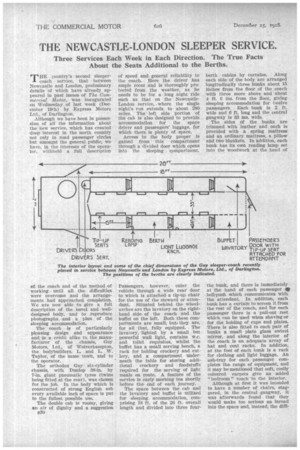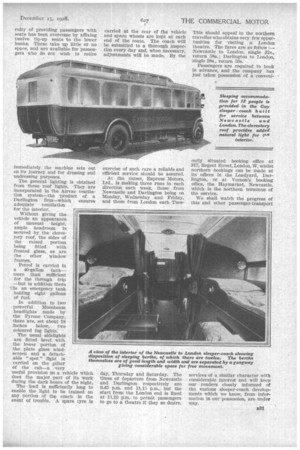THE NEWCASTLE-LONDON SLEEPER SERVICE.
Page 18

Page 19

If you've noticed an error in this article please click here to report it so we can fix it.
Three Services• Each Week in Each Direction. The True Facts About the Seats Additional to the Berths.
Pr HE country's second sleeper-1coach service, that between Newcastle and London, preliminary details of which have already appeared in past issues of The Commercial Motor, was inaugurated on Wednesday of last week (December 10th) by Express Motors Ltd., of Darlington.
Although we have been in possession of all the information about the new service, which has created deep interest in the north country not only in road passenger circles but amongst the general public, we have, in the interests of the operator, withheld a full description
of the coach and of the -method of working until all the difficulties were overcome and the arrangements had approached completion. We are now able :to give a full description of the novel and welldesigned body, andto reproduce photographs_ and a plan of the sleeping accommodation.
Thecoach is of particularly pleasing design and appearance and-is a credit alike to the .manufacturer of the chaSsis, Guy Motors, Ltd., of Wolverhampton, the bodybuilders, L. and L. W. Taylor, of the same town, and to the operator.
The orthodox Guy six-cylinder chassis, with Dunlop 38-in. by 7-in, giant pneumatic tyres (twins being fitted at the rear), was chosen for the job. In the body which is constructed of strong English ash every available inch of space is put to the fullest possible use.
The double cab is roomy, giving an air of dignity and a suggestion n30
of speed and general reliability to the coach. Here the driver has ample room and is thoroughly protected from the weather, as he needs to be for a long night ride such as that on the NewcastleLondon service, where the single night's run extends to about 280 miles. The• left side portion 'of the cab is also designed to provide accommodation • for the spare driver and passengers' luggage, for which there is plenty of space. Access to the body proper is gained from this compartment through a divided door which opens into the sleeping compartment.
Passengers, however, enter the vehicle through a wide rear door to which is attacheda tip-up chair for the use of the steward or attendant. Situated behind the wheelarches are the lavatory on the righthand side of the coach and the buffet on the left. Both these compartments are small, but they are, for all that, fully equipped. The lavatory, lighted by a small but powerful wall light, contains w.c. and toilet requisites, whilst the buffet has a small serving bench, a rack for holding crockery and cutlery, and a compartment underneath the table for storing additional crockery and foodstuffs required for the serving of light meals en route. A feature of the service is early morning tea shortly before the end of each journey.
The space between the cab and the lavatory and buffet is utilized for sleeping accommodation, comprising 18 ft. of the 26 ft. overall length and divided into three four
berth cabins by curtains. Along each side of the body are arranged lengitudinally three bunks about 15 inches from the floor of the coach with three more above and about 4 ft. 6 ins, from the floor, giving sleeping accommodation for twelve passengers. Each bunk is 2 ft. wide and 6 ft. long and the central gangway is 33 ins. wide, 2 The sides of the bunks are trimmed with leather and each is provided with a spring mattress and an ordinary mattress, a pillow and two blankets. in Addition, each bunk has its own reading lamp set into the woodwork at the head of
the bunk, and there is immediately at the hand of each passenger se bell-push which communicates with the attendant. In addition, each bunk has a curtain to screen it from the rest of the coach, and for each passenger there is a pull-out rest which can be used when shaving or for the holding of cups and plates. There is also fitted to each pair of bunks a small plate glass swivel mirror, and along the interior of the coach is an adequate array of hat and coat racks. In addition, at the foot of each bunk is a rack for clothing and light luggage. An ash-tray for each passenger completes the range of equipment, and it may be mentioned that soft, cosily coloured carpets give an added " bedroom " touch -to the interior.
Although at first it was intended to have a number of chairs, staggered, in the central gangway, it was afterwards found that they would make too serious an inroad into the space and, instead, the difil culty of providing passengers with seats has been overcome by affixing twelve tip-up seats to the lower bunks. These take up little or no space, and are available for passengers who do not wish to retire immediately the machine sets out on its journey and for dressing and undressing purpoSes.
The general lighting is obtained from three roof lights. They are incorporated in the ..kirvac ventilation system—the -product of a Darlington firm—which ensures adequate ' ventilation for the interior.
Without giving the vehicle an appearance of unusual height, ample headroom is secured by the clerestorY roof, the sides of the raised portion being fitted with frosted glass, as are the other window frames.
Petrol is carried in a 40-gallon tank— more than sufficient for the through • trip —but in ,addition•there is an emergency tank holding eight gallons of fuel.
In addition to two powerful Moonbeam headlights made by the Pyre,ne Company, there are, set about 18 inches below, two coloured fog lights.
The usual sidelights are fitted level with the lower portion of the plate glass windscreen and a detachable "spot" light is carried on the pillar of the cab—a very useful provision on a vehicle which does the major part of its work during the dark hours of the night.
The lead is sufficiently long to enable the light to be trained on any portion of the coach in the event of trouble. A spare tyre is carried at the rear of the vehicle and spare wheels are kept at each end of the route. The coach will be submitted to a thorough inspection every day and, when necessary, adjustments will be made. By the exercise of such care a reliable and efficient service should be assured.
At the outset, Express Motors, Ltd., is making three runs in each direction each week, those from Newcastle and Darlington being on Monday, Wednesday and Friday, and those from London each Tues
day, Thursday and Saturday. The times of departure from Newcastle and Darlington respectively are 9.45 p.m. and 11.15 p.m., but the start from the London end is fixed at 11.10 p.m. to permit passengers to go to a theatre if they so desire.
This should appeal to the northern traveller who obtains very few opportunities for visiting a London theatre. The fares are as follow :— Newcastle to London, single 32s., return 58s.; Darlington to London, single 28s„ return 538.
Passengers are required to book in advance, and the company has just taken possession of a conveni ently situated booking office at 317, Regent Street, London, W, whilst northern bookings can be made at its offices in the Leadyard, Darlington, or at Vernon's booking office, the Haymarket, Newcastle, which is the northern terminus of the service.
We shall watch the progress of this and other passenger-transport
services of a similar character with considerable interest and will keep our readers closely informed of the various sleeper-coach developments which we know, from information in our possession, are under way.






























